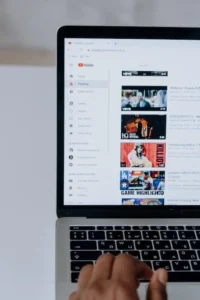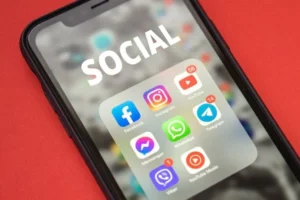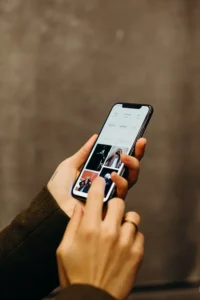How To Make Money From YouTube?

You Can Also Make Money From YouTube Easily Before Make Money From YouTube we must know well about YouTube and keep an eye on every aspect of it. What is YouTube? and how can we Make Money From YouTube? If you want to Make Money From YouTube without any investment, then you are in the right place.
You can Make Money from YouTube 10$ to 100$ day to day. For Example, If you are a video editor you can Make Money From YouTube by sharing your skills to people in the form of reels and helping them people with your skills.
You don’t need to be a video editor or a content writer, but whoever you are or whatever you are good at, make videos of the same and promote your page so whether you are a cook or a graphic designer or a web developer or a web designer or a digital marketer or a logo designer or a photographer.
What is YouTube?

YouTube is a video-sharing platform that allows its users to upload videos. It was created in February 2005 by three people. Steve Chen, Chad Hurley, and Jawed Karim which was bought by Google in November 2006 for $1.65 billion
Here Are Some important aspects of Make Money From YouTube:
Create High-Quality Content:
Produce engaging, informative, and entertaining videos that cater to your target audience. Focus on topics that you’re passionate about and that have the potential to attract viewers.
Build Your Audience:
Consistently upload content and interact with your audience through comments, social media, and community posts. Encourage viewers to subscribe to your channel and turn on notifications to stay updated with your latest uploads.
Monetize Your Videos:
Once you’ve met the eligibility criteria (1,000 subscribers and 4,000 watch hours in the past 12 months), you can apply for the YouTube Partner Program (YPP). Upon approval, you can monetize your videos through ads.
Enable Advertisements:
Enable monetization for your videos by turning on ads through YouTube’s monetization settings. YouTube will display ads before, during, or after your videos, and you’ll earn a share of the ad revenue generated from your content.
Utilize Affiliate Marketing:
Promote products or services relevant to your content through affiliate marketing. Include affiliate links in your video descriptions and encourage viewers to make purchases through your links. You’ll earn a commission for each sale made through your affiliate links.
Offer Channel Memberships:
If you have a loyal fanbase, consider offering channel memberships. Viewers can pay a monthly fee to access perks such as exclusive content, badges, emojis, or members-only live chats.
Create and Sell Merchandise:
Design and sell branded merchandise such as T-shirts, hoodies, mugs, or accessories featuring your channel’s logo or catchphrases. Use YouTube’s merchandise shelf feature to showcase your products directly on your channel.
Crowdfunding:
Engage with your audience through crowdfunding platforms like Patreon or Ko-fi. Offer exclusive perks or rewards to supporters in exchange for their financial contributions. This can provide you with additional income to support your channel.
Sponsorships and Brand Deals:
Collaborate with brands and companies for sponsored content or brand deals. Promote their products or services in your videos in exchange for payment or free products. Ensure that any sponsored content aligns with your channel’s niche and values.
Diversify Revenue Streams:
Explore additional revenue streams such as hosting online courses, selling digital products, or offering consulting services related to your channel’s niche. Diversifying your income sources can help mitigate risks and increase your overall earnings potential.
Remember to comply with YouTube’s policies and guidelines regarding content creation, monetization, and promotions. Building a successful YouTube channel takes time, dedication, and creativity, so stay consistent and continue to refine your content to meet the evolving needs of your audience.
1)Video content
Some ideas for video content across various platforms like YouTube, TikTok, Instagram, and more:
Educational Tutorials:
Create step-by-step tutorials on topics like cooking recipes, DIY crafts, makeup techniques, photography tips, or software tutorials.
Product Reviews and Unboxings:
Review and unbox products relevant to your niche, providing honest opinions, demonstrations, and comparisons to help viewers make informed purchasing decisions.
Vlogs and Day-in-the-Life Videos:
Share glimpses into your daily life, documenting interesting activities, adventures, or routines. Offer insights, reflections, and personal experiences to connect with your audience.
Travel and Adventure Videos:
Capture and share travel experiences, explore new destinations, try local cuisine, and engage in adventurous activities. Inspire viewers with stunning visuals and storytelling.
Storytime and Personal Narratives:
Share personal anecdotes, life lessons, or storytelling videos that resonate with your audience. Offer insights, humor, or heartfelt moments to create emotional connections.
Challenge and Experiment Videos:
Take on challenges, experiments, or social media trends, showcasing your creativity, humor, or problem-solving skills. Involve your audience by encouraging participation or voting on challenges.
Interviews and Collaborations:
Conduct interviews with experts, influencers, or interesting individuals within your niche. Collaborate with other content creators for joint projects, discussions, or challenges.
Educational and Explainer Videos:
Create informative videos that explain complex topics, answer common questions, or provide valuable insights into specific subjects within your expertise or interest.
Animated or Whiteboard Videos:
Produce animated or whiteboard-style videos to explain concepts, illustrate stories, or deliver educational content in a visually engaging format.
Behind-the-Scenes Content:
Offer behind-the-scenes glimpses into your creative process, showing how you plan, produce, and edit your videos. Share bloopers, outtakes, or candid moments to humanize your brand.
Stop Motion or Time-Lapse Videos:
Experiment with stop motion or time-lapse techniques to create visually captivating videos showcasing transformations, processes, or artistic endeavors.
How-to Guides and Life Hacks:
Share practical how-to guides, life hacks, or productivity tips to help viewers solve common problems, improve skills, or streamline their daily routines.
Fitness and Wellness Content:
Provide workout routines, healthy recipes, mindfulness practices, or self-care tips to promote physical and mental well-being among your audience.
Funny and Entertaining Skits:
Produce comedic skits, parodies, or humorous sketches that entertain and engage your audience with laughter and entertainment.
Livestream Events and Q&A Sessions:
Host live events, Q&A sessions, or interactive streams where you can engage directly with your audience, answer questions, and build community in real-time.
Choose video content ideas that align with your interests, expertise, and audience preferences. Experiment with different formats, styles, and storytelling techniques to keep your content fresh, engaging, and memorable.

2)Search and discovery
“Search and discovery” content refers to videos that are designed to be easily found by users through search engines or within the platform’s own search and discovery features. Here are some ideas for creating search and discovery content:
Keyword-Optimized Tutorials:
Create tutorials or how-to videos that address popular search queries within your niche. Optimize your titles, descriptions, and tags with relevant keywords to improve visibility in search results.
Topical Guides and Reviews:
Produce comprehensive guides, reviews, or roundups on trending topics, products, or services. Address common questions and provide valuable insights to attract search traffic.
Educational Explainers:
Develop informative videos that explain complex concepts, theories, or processes within your field of expertise. Use clear explanations and visuals to make your content accessible to a broad audience.
FAQ and Troubleshooting Videos:
Address frequently asked questions or common problems faced by your audience. Offer practical solutions, troubleshooting tips, or step-by-step guides to help viewers resolve their issues.
Comparison and Versus Videos:
Compare different products, services, or solutions within your industry. Use keywords such as “vs,” “versus,” or “comparison” in your titles to attract users comparing options before making a decision.
Beginner’s Guides and Basics:
Create beginner-friendly guides or introductory videos for newcomers to your niche. Cover fundamental concepts, terminology, and essential skills to help beginners get started.
Behind-the-Scenes Insights:
Provide behind-the-scenes insights into your creative process, production techniques, or workflow. Showcase how you research, plan, and execute your content to engage curious viewers.
Local Guides and Recommendations:
Offer recommendations, reviews, or guides related to local businesses, attractions, or events. Target keywords specific to your location to attract users searching for local information.
Trend Analysis and Predictions:
Analyze industry trends, developments, or emerging topics within your niche. Offer insights, predictions, or commentary to position yourself as an authority and attract users seeking timely information.
Evergreen Content:
Create evergreen content that remains relevant and valuable over time. Focus on timeless topics, foundational principles, or enduring trends to attract consistent search traffic.
Keyword Research and Optimization:
Conduct keyword research to identify popular search queries and topics within your niche. Optimize your video titles, descriptions, tags, and thumbnails to align with relevant keywords and improve search visibility.
User-Requested Content:
Pay attention to comments, messages, or feedback from your audience. Create content that directly addresses their questions, interests, or requests to enhance engagement and attract search traffic.
By focusing on search-friendly topics, optimizing your content for relevant keywords, and providing valuable information, you can increase the discoverability of your videos and attract a wider audience through search engines and platform algorithms.

3)Community Engagement
Community engagement content aims to foster interaction, build relationships, and strengthen connections with your audience. Here are some ideas for creating community engagement content:
Q&A Sessions:
Host live or pre-recorded Q&A sessions where you answer questions from your audience. Encourage viewers to submit their questions beforehand or participate in real-time through comments or live chat.
Polls and Surveys:
Use polls or surveys to gather feedback, opinions, or preferences from your audience. Ask questions related to your content, upcoming projects, or community interests to encourage participation and interaction.
Challenges and Contests:
Organize fun challenges, contests, or competitions that encourage your audience to participate and showcase their creativity or skills. Offer prizes, recognition, or shoutouts to winners to incentivize engagement.
Community Shoutouts:
Highlight members of your community by giving shout-outs, featuring their comments, or showcasing their content. Recognize and celebrate the contributions of your audience to foster a sense of belonging and appreciation.
Collaborative Projects:
Collaborate with your audience on creative projects, challenges, or initiatives. Invite them to contribute ideas, artwork, or content that you incorporate into your videos or social media posts, crediting and thanking participants.
Interactive Live Streams:
Host interactive live streams where you engage directly with your audience in real-time. Encourage viewers to ask questions, share their thoughts, or participate in activities such as games, quizzes, or polls.
Community Discussions:
Initiate discussions or debates on topics relevant to your niche or interests. Create space for your audience to share their perspectives, exchange ideas, and engage in respectful dialogue with each other.
Exclusive Community Content:
Offer exclusive content, perks, or benefits to members of your community, such as early access to videos, behind-the-scenes footage, or private livestreams. Provide incentives for joining and participating in your community.
Fan Art and Fan Spotlight:
Showcase fan art, fan-created content, or fan contributions in your videos or social media posts. Highlight the creativity and enthusiasm of your audience and express gratitude for their support.
Meetups and Events:
Organize virtual or in-person meetups, events, or gatherings for your community. Provide opportunities for members to connect, network, and interact with each other in a supportive and inclusive environment.
Feedback and Suggestions:
Encourage your audience to share feedback, suggestions, or ideas for improving your content or community. Actively listen to their input, respond thoughtfully, and implement constructive feedback when possible.
Community Announcements:
Keep your audience informed about updates, announcements, or changes related to your channel, content schedule, or community guidelines. Maintain transparency and open communication to build trust and loyalty.
By actively engaging with your audience, fostering participation, and creating a sense of belonging, you can cultivate a vibrant and supportive community around your content. Prioritize building genuine connections, listening to your audience, and creating value for your community members to nurture long-term engagement and loyalty.

4)Live Streaming
Some popular ideas for live streaming content that you can consider:
Gaming Streams:
Live stream yourself playing video games on platforms like Twitch or YouTube Gaming. Engage with your audience, provide commentary, and interact with viewers through live chat.
Creative Streams:
Showcase your artistic talents by live-streaming drawing, painting, sculpting, or crafting sessions. Share your creative process and techniques while interacting with viewers.
Music Performances:
Live stream musical performances, including singing, playing instruments, or DJing. Take song requests from viewers and engage with your audience in real-time.
Cooking Shows:
Broadcast live cooking demonstrations where you prepare various dishes or share cooking tips and recipes. Interact with viewers, answer questions, and even take cooking challenges or requests.
Fitness Workouts:
Lead live fitness classes, including yoga sessions, cardio workouts, strength training, or dance routines. Provide instruction, motivation, and modifications for different fitness levels.
Talk Shows and Podcasts:
Host live talk shows or podcasts where you discuss specific topics, interview guests, or engage in roundtable discussions with viewers. Address current events, trends, or niche interests.
Educational Content:
Offer live tutorials, workshops, or lectures on subjects such as photography, coding, language learning, or DIY projects. Share your expertise and knowledge with your audience in an interactive format.
Q&A Sessions:
Host live Q&A sessions where you answer questions from viewers on topics related to your expertise, interests, or personal experiences. Foster a direct dialogue with your audience and provide valuable insights.
Virtual Tours and Travel:
Take viewers on virtual tours of interesting locations, landmarks, museums, or travel destinations. Share your experiences, stories, and travel tips while exploring different places together.
Gardening and Nature:
Broadcast live gardening sessions, nature walks, or birdwatching expeditions. Share gardening tips, plant care advice, or insights into local flora and fauna.
Product Reviews and Unboxings:
Live stream product reviews, unboxings, or demonstrations of gadgets, tech products, beauty items, or subscription boxes. Provide honest opinions and insights while engaging with your audience’s feedback.
Charity and Fundraising Events:
Organize live charity streams or fundraising events to support causes you’re passionate about. Encourage donations, raise awareness, and make a positive impact with your audience’s support.
When live streaming, remember to interact with your audience, maintain a consistent schedule, and promote your streams through social media and other channels to maximize viewership. Additionally, ensure that you comply with the platform’s guidelines and policies regarding live-streaming content.

5)YouTube Premium
YouTube Premium offers subscribers access to exclusive content, ad-free viewing, offline playback, and other premium features. Creating content specifically for YouTube Premium subscribers requires a different approach, as it often involves providing additional value beyond what is available on the regular platform. Here are some ideas for YouTube Premium content:
Exclusive Series or Shows:
Produce original series, documentaries, or shows that are only available to YouTube Premium subscribers. Offer high-quality, binge-worthy content with compelling storylines or unique formats.
Extended Episodes or Bonus Content:
Release extended versions of your regular videos, featuring bonus content, behind-the-scenes footage, or deleted scenes exclusively for YouTube Premium subscribers. Provide additional insights or entertainment value to reward their subscription.
Early Access to Videos:
Offer YouTube Premium subscribers early access to your upcoming videos before they’re released to the general public. Create anticipation and excitement by providing exclusive sneak peeks or previews of your content.
Live Events and Concerts:
Host live events, concerts, or performances that are livestreamed exclusively for YouTube Premium subscribers. Give them access to unique experiences, interactive Q&A sessions, or behind-the-scenes access to special events.
Interactive Experiences:
Create interactive experiences or choose-your-own-adventure videos where YouTube Premium subscribers can influence the outcome of the story or engage with the content in unique ways. Offer personalized experiences that cater to their preferences.
Ad-Free Viewing and Background Play:
Emphasize the benefits of ad-free viewing and background play that YouTube Premium offers. Create content that is optimized for uninterrupted viewing experiences, without interruptions from ads or distractions.
Educational Courses or Workshops:
Develop comprehensive educational courses, workshops, or masterclasses on topics within your expertise. Provide in-depth learning opportunities and exclusive resources for YouTube Premium subscribers to enhance their skills or knowledge.
Interactive Challenges and Games:
Design interactive challenges, quizzes, or games that YouTube Premium subscribers can participate in. Offer rewards, prizes, or special perks for subscribers who engage with the content and complete challenges.
Personalized Content Recommendations:
Curate personalized content recommendations or playlists tailored to the interests and preferences of YouTube Premium subscribers. Use algorithms or user data to suggest relevant videos or series that match their viewing habits.
Exclusive Community Features:
Create exclusive community features or forums where YouTube Premium subscribers can connect, interact, and engage with each other. Foster a sense of community and belonging among subscribers by providing opportunities for networking and collaboration.
When creating YouTube Premium content, focus on providing value, exclusivity, and a premium viewing experience for subscribers. Tailor your content to meet the unique needs and expectations of YouTube Premium users, and leverage the platform’s features to offer additional benefits and perks.

6) User Accounts
Creating user account content involves producing videos that cater to specific interests, needs, or challenges faced by users across various platforms. Here are some ideas for user account content:
Product Reviews and Demonstrations:
Create in-depth reviews and demonstrations of products relevant to your target audience. Provide honest assessments, highlight features, and offer practical advice to help users make informed purchasing decisions.
Tutorial and How-To Guides:
Produce tutorials and how-to guides that address common questions or challenges faced by users. Offer step-by-step instructions, tips, and troubleshooting advice to help users accomplish tasks or learn new skills.
Topical Discussions and Debates:
Host discussions, debates, or roundtable conversations on topics of interest to your audience. Invite guest experts or influencers to share their perspectives and engage in meaningful dialogue with users.
Personal Development and Self-Improvement:
Create content focused on personal development, self-improvement, and wellness. Share insights, strategies, and practical tips to help users enhance their well-being, productivity, and overall quality of life.
Educational and Informative Content:
Develop educational and informative content on subjects within your expertise or niche. Offer valuable insights, research findings, or practical advice to help users expand their knowledge and skills.
Entertainment and Lifestyle Vlogs:
Produce vlogs and lifestyle content that showcase your daily experiences, adventures, or interests. Share stories, anecdotes, and behind-the-scenes glimpses into your life to entertain and connect with users.
Community Engagement and Interaction:
Engage with your audience through community-focused content such as Q&A sessions, polls, challenges, or shoutouts. Foster a sense of belonging and connection by actively involving users in your content creation process.
Interviews and Collaborations:
Conduct interviews with influencers, experts, or interesting individuals within your niche. Collaborate with other content creators to create joint projects, discussions, or challenges that appeal to users.
Travel and Exploration Videos:
Share travel experiences, adventure stories, or destination guides to inspire and inform users. Capture stunning visuals, share travel tips, and offer recommendations to help users plan their adventures.
Behind-the-Scenes Content:
Provide behind-the-scenes glimpses into your creative process, production techniques, or workflow. Share insights, challenges, and lessons learned to give users a deeper understanding of your content creation journey.
Motivational and Inspirational Content:
Create motivational and inspirational content that uplifts and empowers users. Share stories of resilience, success, and personal growth to inspire positive change and encourage users to pursue their goals.
Productivity and Time Management Tips:
Offer practical tips, strategies, and tools to help users improve their productivity and time management skills. Share techniques for staying focused, setting goals, and maximizing efficiency in various aspects of life.
Tailor your user account content to resonate with the interests, preferences, and needs of your target audience. Strive to provide value, authenticity, and relatability in your videos to foster meaningful connections and build a loyal community of users.

7)Video Reach
“Video reach content” refers to videos specifically designed to maximize their reach and visibility on platforms like YouTube, TikTok, Instagram, and others. Here are some strategies and ideas for creating video reach content:
Optimize for SEO:
Research relevant keywords and phrases to optimize your video titles, descriptions, and tags for search engines. Use tools like Google Keyword Planner or Tube Buddy to identify high-volume keywords in your niche.
Engaging Thumbnails:
Create eye-catching thumbnails that grab viewers’ attention and entice them to click on your video. Use bold fonts, vibrant colors, and compelling imagery that accurately represents the content of your video.
Catchy Titles:
Craft compelling titles that are concise, descriptive, and intriguing. Incorporate keywords and phrases that are likely to resonate with your target audience and encourage clicks.
Short and Snappy Content:
Create concise, attention-grabbing videos that quickly capture viewers’ interest and deliver value within the first few seconds. Aim to hook viewers early and keep them engaged throughout the video.
Utilize Trends and Challenges:
Incorporate popular trends, challenges, or memes into your content to capitalize on their virality and reach. Stay updated with current trends and adapt your content to align with what’s resonating with your target audience.
Cross-Promotion and Collaborations:
Collaborate with other content creators or influencers in your niche to cross-promote each other’s videos. Share each other’s content on social media, collaborate on joint projects, or appear as guests in each other’s videos to expand your reach.
Post Consistently:
Maintain a consistent posting schedule to keep your audience engaged and active. Regularly upload new content to stay relevant in your niche and increase your chances of being recommended by the platform’s algorithms.
Engage with Your Audience:
Respond to comments, messages, and feedback from your audience to foster engagement and build a loyal community. Encourage viewers to like, comment, and share your videos to increase their reach organically.
Use Hashtags Wisely:
Include relevant hashtags in your video descriptions or captions to improve discoverability and reach on platforms like Instagram, TikTok, and Twitter. Research popular hashtags in your niche and use them strategically to reach a wider audience.
Promote Your Videos:
Share your videos across multiple platforms and channels to increase visibility and reach. Use social media, email newsletters, blogs, and online communities to promote your content and attract new viewers.
Optimize for Mobile Viewing:
Ensure that your videos are optimized for mobile viewing, as many users access content on their smartphones. Use vertical or square formats for platforms like Instagram and TikTok, and make sure your content is visually appealing and easy to consume on smaller screens.
By implementing these strategies and creating video reach content that is optimized for discovery, engagement, and share-ability, you can increase your videos’ reach and visibility across various platforms. Keep experimenting with different approaches and analyzing your performance metrics to refine your content strategy and maximize your impact.

8)Global Reach
Creating content with global reach involves producing videos that appeal to a diverse, international audience and can be understood and appreciated by viewers from different cultures, backgrounds, and languages. Here are some strategies and ideas for creating global reach content:
Universal Themes and Topics:
Focus on themes and topics that have universal appeal and relevance across cultures and regions. Examples include love, friendship, family, personal growth, and human experiences that resonate with people worldwide.
Multilingual Content:
Offer subtitles or translations in multiple languages to make your content accessible to a global audience. Consider providing captions or subtitles in English, as it’s widely understood, along with translations in other languages based on your audience demographics.
Cultural Sensitivity and Awareness:
Respect cultural differences and sensitivities when creating content. Avoid stereotypes, offensive language, or topics that may be sensitive or controversial in certain cultures. Conduct research and seek feedback to ensure your content is inclusive and respectful.
Visual Storytelling:
Use visual storytelling techniques to convey messages and emotions that transcend language barriers. Focus on compelling visuals, facial expressions, body language, and music to evoke emotions and connect with viewers on a deeper level.
Travel and Exploration:
Showcase diverse cultures, landscapes, and traditions from around the world through travel vlogs, documentaries, or exploration videos. Share your experiences, insights, and discoveries to inspire curiosity and appreciation for different cultures.
Global Challenges and Solutions:
Address global issues, challenges, and solutions that impact people worldwide, such as climate change, poverty, education, or healthcare. Raise awareness, share perspectives, and promote positive actions to drive change and make a difference.
Collaborate with International Creators:
Collaborate with content creators from different countries, cultures, or regions to create joint projects, exchange ideas, and showcase diverse perspectives. Collaboration can help you reach new audiences and foster cross-cultural understanding.
Cultural Exchange and Traditions:
Share insights into cultural traditions, festivals, holidays, and celebrations from around the world. Explore unique customs, rituals, and practices to promote cultural exchange and appreciation among your audience.
Music and Dance:
Highlight music, dance, and performing arts from various cultures and genres. Showcase traditional musical instruments, dance styles, or performances that showcase the richness and diversity of global cultures.
Food and Cuisine:
Explore the world of global cuisine by showcasing traditional dishes, recipes, and cooking techniques from different countries and regions. Share culinary experiences, food stories, and cultural insights to tantalize viewers’ taste buds and ignite their curiosity.
Virtual Tours and Experiences:
Offer virtual tours, experiences, or immersive journeys that allow viewers to explore iconic landmarks, historical sites, or natural wonders from around the world. Use technology to transport viewers to distant places and broaden their horizons.
Language Learning and Education:
Create educational content that helps viewers learn new languages, understand different cultures, or gain insights into global issues. Offer language lessons, cultural explanations, or cross-cultural communication tips to promote intercultural understanding.
By incorporating these strategies and ideas into your content creation process, you can produce videos with global reach that resonate with audiences worldwide and contribute to cross-cultural exchange, appreciation, and understanding. Keep experimenting, learning, and adapting your approach to connect with diverse audiences and make a positive impact on a global scale.

9)Educational Content
Creating educational content is a valuable way to share knowledge, teach new skills, and provide value to your audience. Here are some ideas for educational content across different platforms:
Tutorial Videos:
Create step-by-step tutorial videos that teach viewers how to do something, such as cooking a recipe, playing a musical instrument, or mastering a software tool. Break down complex tasks into easy-to-follow instructions.
Explainer Videos:
Produce explainer videos that simplify complex concepts or topics. Use visuals, animations, and clear explanations to help viewers understand difficult concepts in areas like science, technology, finance, or philosophy.
How-to Guides:
Develop comprehensive how-to guides that walk viewers through a process or procedure. Cover topics like DIY projects, home repairs, gardening tips, or personal finance management.
Educational Challenges:
Create challenges or assignments that encourage viewers to learn and practice new skills. Provide guidance, resources, and feedback to help participants achieve their learning goals.
Lecture Series:
Offer in-depth lecture series on specific subjects or disciplines. Break down complex topics into manageable lessons and provide structured learning experiences for viewers interested in academic or professional development.
Language Learning Lessons:
Teach language learning lessons for beginners or intermediate learners. Cover vocabulary, grammar, pronunciation, and cultural insights to help viewers improve their language skills.
STEM Education:
Produce educational content focused on science, technology, engineering, and mathematics (STEM). Explore topics like physics experiments, coding tutorials, robotics projects, or engineering principles.
Art and Creativity Workshops:
Host art workshops or creativity sessions that teach viewers how to draw, paint, sculpt, or create digital art. Provide demonstrations, techniques, and tips to inspire creativity and artistic expression.
History and Culture Lessons:
Explore historical events, cultural traditions, and significant figures from around the world. Share insights, anecdotes, and stories that educate viewers about different periods in history or aspects of global culture.
Health and Wellness Advice:
Offer health and wellness advice on topics like nutrition, fitness, mental health, and stress management. Provide practical tips, exercises, and strategies to help viewers improve their overall well-being.
Career Development Tips:
Provide career development tips, job search advice, and professional skills training. Cover topics like resume writing, interview preparation, networking, and entrepreneurship to help viewers advance their careers.
Financial Literacy Education:
Teach financial literacy concepts such as budgeting, saving, investing, and managing debt. Offer practical advice, strategies, and resources to help viewers achieve their financial goals and build wealth.
When creating educational content, prioritize clarity, accuracy, and engagement to ensure that your videos effectively deliver valuable information to your audience. Tailor your content to meet the needs and interests of your target viewers, and continuously seek feedback to improve and refine your educational offerings over time.

10)Culture Impact
Cultural impact content aims to explore, analyze, and discuss the influence of cultural phenomena on society, identity, and human behavior. Here are some ideas for creating culture-impact content:
Cultural Critiques and Analyses:
Produce in-depth analyses and critiques of cultural trends, movements, or phenomena. Explore topics such as the impact of social media on relationships, the portrayal of marginalized groups in media, or the influence of globalization on local cultures.
Historical Perspectives:
Delve into the historical context of cultural phenomena and examine how they have evolved. Explore pivotal moments, events, or figures that have shaped culture and society.
Media and Pop Culture Reviews:
Review and analyze media, entertainment, and pop culture artifacts such as films, TV shows, music, literature, or video games. Discuss their cultural significance, themes, and impact on society.
Cultural Identity Exploration:
Explore themes of cultural identity, belonging, and representation. Discuss the experiences of minority groups, immigrants, or marginalized communities and examine how they shape individual and collective identities.
Globalization and Cultural Exchange:
Examine the effects of globalization on culture, including the spread of ideas, values, and practices across borders. Discuss the opportunities and challenges of cultural exchange in an interconnected world.
Social Justice and Activism:
Spotlight social justice movements, activism efforts, and grassroots initiatives that seek to challenge cultural norms, advocate for equality, and promote social change. Amplify voices of underrepresented communities and discuss strategies for advancing social justice.
Cultural Heritage Preservation:
Explore efforts to preserve and protect cultural heritage, including historical landmarks, traditions, languages, and artifacts. Discuss the importance of cultural preservation in maintaining identity, fostering understanding, and celebrating diversity.
Intersectionality and Diversity:
Discuss the intersectionality of cultural identities, including race, gender, sexuality, class, and ability. Examine how different aspects of identity intersect and influence experiences of privilege, discrimination, and empowerment.
Cultural Celebrations and Festivals:
Highlight cultural celebrations, festivals, and holidays from around the world. Explore their significance, traditions, and rituals, and discuss how they contribute to cultural cohesion and community bonding.
Environmental and Sustainable Practices:
Examine the cultural impact of environmental degradation and climate change. Discuss sustainable practices, eco-friendly innovations, and efforts to promote environmental stewardship and conservation.
Cultural Diplomacy and Soft Power:
Explore the role of cultural diplomacy and soft power in international relations. Discuss how cultural exchange, artistic expression, and cultural diplomacy initiatives can foster understanding, cooperation, and peace among nations.
Ethical Consumption and Consumerism:
Discuss the ethical implications of consumer culture, including issues such as fast fashion, consumerism, and fair trade. Explore sustainable and ethical alternatives and advocate for conscious consumption practices to make money from YouTube.
When creating culture-impact content, prioritize empathy, respect, and nuance to foster meaningful discussions and promote understanding across diverse perspectives. Use your platform to amplify voices, challenge stereotypes, and advocate for positive social change within your sphere of influence.

11)Monetization
Creating YouTube monetization content involves producing videos to generate revenue through various monetization features available on the platform. Here are some ideas for YouTube monetization content to make money from YouTube:
Ad-Supported Videos:
Create videos that are eligible for monetization through ads displayed before, during, or after your content. Focus on producing high-quality, engaging videos that attract a wide audience and encourage longer watch times to maximize ad revenue.
Sponsored Content:
Collaborate with brands or sponsors to create sponsored content. Promote products, services, or events in your videos in a way that aligns with your audience’s interests and provides value to both the sponsor and your viewers.
Affiliate Marketing:
Incorporate affiliate links in your video descriptions or through annotations to promote products or services. Earn commissions for sales generated through your affiliate links, and provide honest recommendations and reviews to build trust with your audience.
Merchandise Sales:
Create and sell branded merchandise such as clothing, accessories, or digital products through your YouTube channel. Use platforms like Teespring or Spreadshop to design and sell custom merchandise to your audience.
Channel Memberships:
Offer channel memberships to your viewers, providing exclusive perks, benefits, or access to special content in exchange for a monthly subscription fee. Provide value to your members through exclusive badges, emojis, or behind-the-scenes content.
Super Chats and Super Stickers:
Enable Super Chats and Super Stickers during live streams to allow viewers to purchase and send messages or stickers that are highlighted during the stream. Encourage viewer interaction and engagement to increase Super Chat revenue.
Premium Content:
Produce premium content, such as extended versions of your videos, bonus footage, or exclusive series, that is available to subscribers or paying users. Offer value-added content to incentivize subscriptions or one-time purchases.
Crowdfunding Campaigns:
Launch crowdfunding campaigns through platforms like Patreon or Kickstarter to support your content creation efforts. Offer rewards, incentives, and perks to backers in exchange for their financial support.
In-Video Sponsorships:
Integrate sponsored messages or shoutouts directly into your videos. Work with sponsors to create custom segments or branded content that seamlessly fits within your video’s narrative and provides value to your audience.
Educational Courses or Workshops:
Develop and sell educational courses, workshops, or digital products related to your niche or expertise. Use your YouTube channel to promote and market your courses, driving sales and revenue through course enrollments.
Live Events and Ticket Sales:
Organize and promote live events, workshops, or meet-and-greets for your audience. Sell tickets or access passes to your events, and use your YouTube channel to generate excitement and drive ticket sales.
Brand Partnerships and Collaborations:
Collaborate with brands on sponsored content, product placements, or promotional campaigns. Negotiate partnerships that align with your channel’s values and audience interests, and disclose sponsored content transparently to your viewers.
When creating YouTube monetization content, prioritize providing value to your audience and maintaining authenticity and transparency in your monetization efforts. Focus on building long-term relationships with your viewers and delivering content that resonates with their interests and preferences while leveraging monetization features to generate revenue and support your content creation endeavors.

What is Video Content?
YouTube Video content consists of a wide range of video cartography. Here Are Some Common types of video content:
1)Vlogs
2)Gaming
3)Tutorials and How-Tos
4)Educational Content
5)Entertainment:
6)Product Reviews
7)Music Videos
8)Documentaries
9)Travel Videos
10)Fitness and Health
11)Livestreams
12)Animation
13)News And Commentary
14)Unboxings
15)Reaction Videos
1)Vlogs:
Personal video blogs that showcase the content creator’s daily life, experiences, and adventures. You Can Make Vlogs Doing Some Interesting things
2)Gaming
Videos Consist of Playing Games. For Example Nintendo Ubisoft Electronic Arts 2K Microsoft Sony Interactive Entertainment Epic Games.
3)Tutorials and How-Tos:
Instructional videos that teach viewers how to do something, whether it’s a makeup tutorial, a DIY project, or a software tutorial.
4)Educational Content:
Videos That Consist On Educational Purpose To Educate Users About SomeThing, For Example, Science, Physics, Chemistry
5)Entertainment:
Videos That Are For Entertainment Purposes For Example Sketchings, Cartoons, Funny Videos
6)Product Reviews:
Videos Consist on Giving Reviews On Some Products Reviews Must Be Honest It Helps To Grow Your Channel
7)Music Videos
Official music videos from artists, as well as cover songs, remixes, and music-related content.
8)Documentaries
Longest Form Of Videos That Explains The Topics of Real World Events and Adventures. Sometimes Providing In-Depth Analysis and Interviews
9)Travel Videos
Videos Consist of travel vlog experiences, Destination Guides, Reviews On hotels, and Expenses.
10)Fitness and Health
Workouts Health Experiences Health Advice Fitness Guide Nutrition Tips Good Activities
11)Livestreams
Real-Time Broadcast Videos That Allow Creator To Interact With Their Audience Live. This Can consist of live video games movies and music
12)Animation
Animated Contents Consists of short Films For Example Cartoons and Animated series
13)News And Commentary
Videos Consist of the Latest Events News And New Events Providing the Latest Commentary on various points
14)Unboxings
Videos Where The Creator Opens and shows The newly purchased Products with commentary and sometimes with music
15)Reaction Videos
Videos Where The Creator Reacts On the Comments Trailer and Content With The Permission Of Other Creator
Creating unique and engaging content is key to standing out on YouTube and attracting viewers. Here are some ideas for unique content that may help you earn from YouTube:
Niche Expertise:
Share your expertise in a specific niche or industry. This could be anything from rare hobbies, unusual skills, or a deep dive into a specific subject matter.
Behind-the-Scenes:
Take your viewers behind the scenes of your life or work. This could include a day in the life, how you create your content, or the process of running your business
Challenge Videos:
Create and participate in unique challenges that are related to your niche or interests. Challenge videos often attract attention and engagement.
Interactive Content:
Create interactive content that involves your audience, such as polls, quizzes, or Q&A sessions. This encourages viewer participation and engagement.\
Educational Experiments:
Conduct unique experiments or projects related to your niche. This could be scientific experiments, social experiments, or creative projects.
Local or Cultural Exploration:
Explore and showcase unique aspects of your local area or a particular culture. This could include travel vlogs, interviews with locals, or insights into local traditions.
Storytelling Series:
Develop a storytelling series around a specific theme or topic. This could be fictional or based on personal experiences.
Review Uncommon Products:
Review products that are unusual or not commonly known. This could include niche gadgets, unique foods, or obscure items.
Interviews with Unconventional Guests:
Conduct interviews with guests who have unique or unconventional stories or experiences to share.
Historical Deep Dives:
Explore and explain historical events, mysteries, or lesser-known stories in an engaging and accessible way.
Custom Creations:
Showcase your creative skills by designing and building custom creations, whether it’s art, crafts, or DIY projects.
Tech and Innovation:
Stay on top of emerging technologies and innovations, and create content that explains, reviews, or explores these advancements.
Virtual Reality (VR) Content:
Create immersive experiences using virtual reality technology. This could include VR travel, gaming, or virtual tours.
Language Learning:
Teach a language or share language learning tips, especially for less commonly taught languages.
Time-Lapse or Hyper-Lapse Videos:
Capture and showcase the passage of time in unique ways, whether it’s a time-lapse of a cityscape or a hyper-lapse of a creative project.
An enlightening piece that’s very well-written.